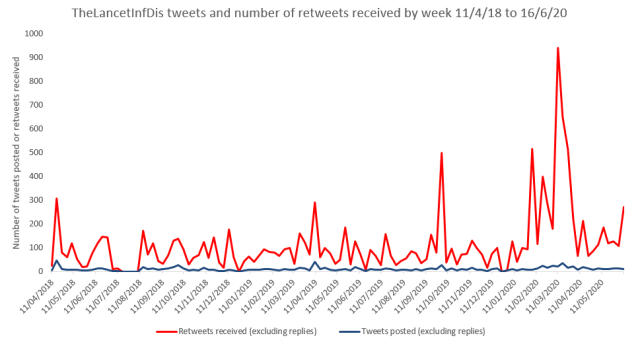This is another post in an occasional series of social media analysis that didn’t reach the pages of peer reviewed journals. It was completed on 28 June 2020, rejected by Lancet Infectious Diseases on 16 July 2020.
Article, very slightly modified, follows…
So much has changed in such a short time. It is difficult to stand back and take a long view. In this article I explore the way that infectious diseases messages have been shared via social media over a period of over two years (11 April 2018 to 18 June 2020), including the pandemic. The detail is provided in two Wakelet summaries – one for tweets by the Journal, the other for retweets by the Journal. Briefly, I used a quirk of Twitter analysis that allows data extracts over a longer period than normal by looking at a single account (@TheLancetInfDis). The original NodeXL extract provided data centred on the Journal’s Twitter account. I remapped this to chart wider connections and updated the data a week later. This approach provided up-to-date information on 1,356 tweets by @TheLancetInfDis account and 1,840 tweets by 371 other accounts which the journal retweeted.

|
Prior to the pandemic the Journal covered a wide range of topics: an “angiostrongyliasis to zoster” of infectious disease, with TB, malaria, HIV, antimicrobial resistance and vaccination popular topics. Since January 2020 there has been a stark narrowing of topics, with COVID-19 related terms dominating: though the Journal continued to tweet about topics from anthrax to zika, two thirds of the hashtags used were COVID-19 related. Interactive word clouds provide detail and allow exploration of the individual tweets (you can access these by clicking on the images below, or fuller information in the Wakelet summary of tweets).
There has simultaneously been a step change in the reception of the Journal’s tweets, peaking in March. During the pandemic, tweets by the Journal received twice as many retweets as before and the content retweeted by the Journal reached a much wider audience (though that will be influenced by a range of factors as some of these retweeted posts were already “going viral”).

For the full 26-month period 42/100 of the Journal’s top tweets and 83/100 of the top retweeted posts were about COVID-19. It is not possible from these data to separate out whether these tweets – by the Journal or other tweeters – were shared by the general public or individuals and organisations with a specialist interest in infectious disease. Nonetheless, the individual tweets posted and retweeted provide an international view of the pandemic including research, ethics, public health, clinical, epidemiological, pharmacological, political and social dimensions.
Many of the lessons from COVID-19 are transferable to other infectious diseases. Hopefully the awareness, interest and connections generated during the pandemic can be converted into wider knowledge of infectious diseases among professionals and public after the pandemic.
Dr Graham Mackenzie, GPST2, Edinburgh, Scotland
16 July 2020.







